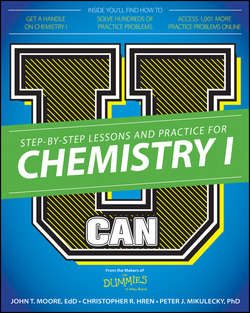Читать книгу U Can: Chemistry I For Dummies - Hren Chris - Страница 13
На сайте Литреса книга снята с продажи.
Part I
Chapter 2
Using and Converting Units
Familiarizing Yourself with Base Units and Metric System Prefixes
ОглавлениеMuch of the work chemists do involves measuring physical properties, such as the mass, volume, or length of a substance. Because chemists must be able to communicate their measurements to other chemists all over the world, they need to speak the same measurement language. This language is the SI system of measurement, related to the metric system, which you’ve hopefully used before. Minor differences exist between the SI and metric systems, but for the most part, they’re very similar.
To correctly use the SI system, you need to have a firm understanding of what each prefix means. The good news: The SI system is a decimal system. In other words, it’s easy to use as long as you know the prefixes.
SI has base units for mass, length, volume, and so on, and prefixes modify the base units. For example, kilo– means 1,000; a kilogram is 1,000 grams, and a kilometer is 1,000 meters. Use Table 2-1 as a handy reference for the abbreviations and meanings of some selected various SI prefixes.
Table 2-1 SI (Metric) Prefixes
The next step in mastering the SI system is to figure out all the possible units that you can run into when solving problems. Here’s a quick explanation of the most common types of units you’ll encounter.
Units of length
The base unit for length in the SI system is the meter. The exact definition of meter has changed over the years, but it’s now defined as the distance that light travels in a vacuum in of a second. Here are some SI units of length:
1 millimeter (mm) = 1,000 micrometers (µm)
1 centimeter (cm) = 10 millimeters (mm)
1 meter (m) = 100 centimeters (cm)
1 kilometer (km) = 1,000 meters (m)
Some common English-to-SI-system length conversions are
1 mile (mi) = 1.61 kilometers (km)
1 yard (yd) = 0.914 meters (m)
1 inch (in.) = 2.54 centimeters (cm)
Units of mass
The base unit for mass in the SI system is the kilogram. It’s the weight of the standard platinum-iridium bar found at the International Bureau of Weights and Measures. Here are some SI units of mass:
1 milligram (mg) = 1,000 micrograms (µg)
1 gram (g) = 1,000 milligrams (mg)
1 kilogram (kg) = 1,000 grams (g)
Some common English-to-SI-system mass conversions are
1 pound (lb) = 454 grams (g)
1 ounce (oz) = 28.4 grams (g)
1 pound (lb) = 0.454 kilograms (kg)
1 grain (gr) = 0.0648 grams (g)
1 carat (car) = 200 milligrams (mg)
Units of volume
In the SI system, volume is measured in base units called cubic meters. However, chemists normally use the liter, 0.001 m3, to measure volume. Here are some SI units of volume:
1 milliliter (mL) = 1 cubic centimeter (cm3) = 1,000 microliters (μL)
1 liter (L) = 1,000 milliliters (mL)
Some common English-to-SI-system volume conversions are
1 quart (qt) = 0.946 liters (L)
1 pint (pt) = 0.473 liters (L)
1 fluid ounce (fl oz) = 29.6 milliliters (mL)
1 gallon (gal) = 3.78 liters (L)
Units of temperature
Kelvin is the base unit for temperature in the SI system. 0 K is called absolute zero, the temperature at which all atomic/molecular motion ceases. Water freezes at 273 K and boils at 373 K. Following are the three major temperature conversion formulas:
Celsius to Fahrenheit:
Fahrenheit to Celsius:
Celsius to Kelvin:
Units of pressure
The SI unit for pressure is the pascal, where 1 pascal equals 1 newton per square meter. (A newton is a unit of force equal to 1 kg·m/s2.) But pressure can also be expressed in a number of ways, so here are some common pressure conversions:
1 millimeter of mercury (mm Hg) = 1 torr
1 atmosphere (atm) = 760 millimeters of mercury (mm Hg) = 760 torr
1 atmosphere (atm) = 29.9 inches of mercury (in. Hg)
1 atmosphere (atm) = 14.7 pounds per square inch (psi)
1 atmosphere (atm) = 101 kilopascals (kPa)
Units of energy
The SI unit for energy (heat being one form) is the joule, but most folks still use the metric unit of heat, the calorie. Here are some common energy conversions:
1 calorie (cal) = 4.184 joules (J)
1 nutritional (food) Calorie (Cal) = 1 kilocalorie (kcal) = 4,184 joules (J)
1 British thermal unit (BTU) = 252 calories (cal) = 1,053 joules (J)
SI base units
In case you’re looking for a simple and handy way to keep track of the most common SI base units, look at Table 2-2 to see them all nicely arranged for your enjoyment.
Table 2-2 SI Base Units
Examples
Q. You measure a length to be 0.005 m. How can this be better expressed using a metric system prefix?
A. 0.005 is , or 5 mm.
Q. What metric base unit would be the most appropriate to use if you were going to measure the distance a runner covers during a marathon?
A. Meters are used to measure how long something is or how much distance is covered. When taking and reading measurements, remember which units you’re using and understand which unit best applies.
Practice Questions
1. How many nanometers are in 1 cm?
2. Your lab partner has measured the mass of your sample to be 2,500 g. How can you record this more nicely (without scientific notation) in your lab notebook using a metric system prefix?
Practice Answers
1. . Both 102 centimeters and 109 nanometers equal 1 meter. Set the two measurements equal to one another (102 cm = 109 nm) and solve for centimeters by dividing. This conversion tells you that , or .
2. 2.5 kg. Because 1,000 g are in 1 kg, simply divide 2,500 by 1,000 to get 2.5.
